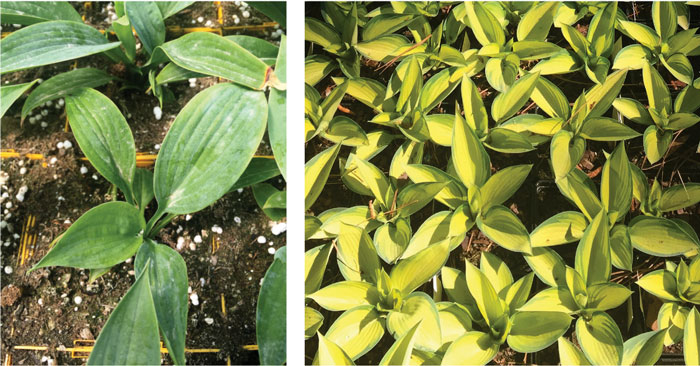8/1/2020
Need a Light Bulking?
Paul Pilon

If you know me, you’ve likely already connected the dots and recognize that I like to use lighting under certain circumstances. It’s not that I own stock in XYZ lighting or anything like that. It’s just amazing how light quality, intensity, total amount per day (daily light integral or DLI) and duration (daylength) can influence how a crop looks or grows and I’m not afraid to use lighting to help achieve certain objectives.
Before I get to the topic I wanted to discuss in this article, let’s review some of the ways light influences crop development:
• Light is essential for photosynthesis.
• Light intensity can be used to maximize plant growth and increase yields.
• Cuttings root the best in propagation when the daily light integral is between 8 and 10 mols per day (5 mols/day is the absolute minimum).
• The DLI should be at least 10 mols per day for finishing perennials in containers. For most perennials, DLIs of greater than 20 mols per day result in the highest quality attributes (habit, lateral branching, basal shoots and flower color).
• Several types of perennials flower faster when they’re grown with higher light intensities.
• Many perennials require long daylengths to initiate flowering (long-day plants)—only a few require short days.
• The photoperiod can also be used to keep long-day plants from flowering (providing short days). This is useful in propagation, during the bulking phase and for producing stock plants.
• Red light aids in seed germination.
• The ratio of red to far red light influences flower initiation and stem elongation.
This is a very general listing of how light influences plant growth, flowering and plant quality. I think you get the idea; if you grow plants, light is very important. Now let’s look at some examples of how lighting is beneficial during certain times of the year for bulking hostas.
Daylength affects growth
Ever wonder why it’s recommended to plant hostas in June or July for sales the following spring? Perhaps you thought they were slow growing and required this extended grow time. That may be true for some cultivars, but most hostas have a reasonably good growth rate. The real reason growers plant hostas in the early summer is daylength. Hostas require long daylengths to keep them actively growing (rooting and top growth). I’ll share two examples of how hosta growth slows down under short daylengths.
The first example is when hostas are forced in the late winter for early spring sales. For this conversation, let’s look at a scenario where the hostas were planted during the previous June, established, bulked up and overwintered. For early April shipping, the grower turned on the heat in mid-February to force growth. After several leaves unfolded, the plants appeared to stall and no additional leaves unfolded. The plants just sat there and hung out; this is referred to as a vegetatively dormant state.
Essentially, the plants received enough cold for them to wake up from dormancy with the warm temperatures they were receiving in the greenhouse. However, once some leaves unfolded, they perceived the naturally short daylengths and realized they weren’t supposed to be growing, so the plant put itself in a holding pattern since it knew it shouldn’t be growing under the short daylengths.
This lack of active growth continued until mid-April when the daylengths became longer. From then on, the hostas resumed growth and unfolded new leaves. If you force hostas for early spring sales, I’m sure you’ve seen what I’m describing.
 The second example is a grower who received their hosta bareroot starting materials in mid-August. The hostas were planted and over the next couple of weeks they noticed that some varieties developed a few roots and new leaves while others had no new top growth or new roots developing. Similar to the reduced growth observed in the spring, the less-than-expected establishment and growth is also due to shorter daylengths.
The second example is a grower who received their hosta bareroot starting materials in mid-August. The hostas were planted and over the next couple of weeks they noticed that some varieties developed a few roots and new leaves while others had no new top growth or new roots developing. Similar to the reduced growth observed in the spring, the less-than-expected establishment and growth is also due to shorter daylengths.
Pictured far left: This Hosta Fragrant Blue is entering the vegetatively dormant state in the late summer. This plant isn’t actively unfolding new leaves. Pictured left: This group of Hosta Gold Standard is actively growing in the late spring when the daylengths are naturally long.
The response to shorter daylengths is very variety-specific. I’ve evaluated numerous hosta plantings over the years and typically see growth reductions on more daylength-sensitive cultivars in early to mid-August, while others don’t slow down until early September or even later.
A light bulking
Interestingly, in Grand Rapids, Michigan, the natural daylength is 13 hours and 26 minutes long on April 15. The days get longer every day after that until August, when the daylengths become shorter every day and are 13 hours and 26 minutes long on August 26. I’m not saying the critical daylength for hosta growth is 13 hours and 26 minutes; it’s just a good reference point demonstrating the growth responses described in the examples above correlates to natural daylengths of similar durations.
If more bulking and/or rooting is needed, I recommend providing long days using daylength extension lighting to provide at least 14-hour daylengths or extending the days with night interruption lighting (10:00 p.m. to 2:00 a.m.) beginning in early August (also known as mum lighting to prevent flowering in garden mums). This isn’t high intensity lighting; aim to deliver approximately 10 footcandles of light at the furthest point from the light source. This is the same intensity and durations used to promote flowering on many long-day perennials in the spring. Most light sources can be used.
I’d continue the long-day lighting until the growth stops due to cold temperatures in the fall or once the leaves begin to turn yellow. You can keep extending the growing season by putting the hostas in a heated structure with the lighting described above. It’s not necessary to light all hosta cultivars, just the small ones.
This trick doesn’t replace the benefits of planting hostas in June or July when the days are naturally long, but can be an effective method of promoting growth for bulking during the late summer and early fall if the plants are on the small side. (FYI—lighting can be used on small hostas again in the spring once growth resumes after dormancy or when planting new crops during the late winter.) GT
Paul Pilon is a Perennial Production Consultant and editor-at-large of the Perennial Pulse e-newsletter. Feel free to contact him with article topics or to address your perennial production challenges. He can be reached at paul@perennialsolutions.com.